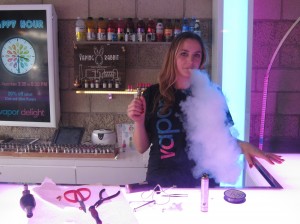
The crowd at the Santa Monica bar was relaxed and engaged in friendly conversation. They each held metal tubes a few inches in length. Every moment or so they put these cartridges to their mouths, sucked in, and then exhaled to blow out giant clouds of white vapor, which dissipated quickly.
For a moment the scene looked like what was once a common sight in this country but today virtually nonexistent: people hanging out at a bar and smoking.

But these people were not puffing on cigarettes but “vaping,” toking on an electronic device that delivers a dose of nicotine through a haze of flavored vapor.
And the bar was not offering up cocktails but more than 150 flavored samples of electronic cigarettes. Vapor Delight on Lincoln Boulevard is one of two electronic cigarette vendors in Santa Monica, part of a growing trend sweeping the country.
You don’t need a match to enjoy an electronic cigarette. There is no burning of tobacco leaves. Instead, a battery-powered cartridge heats up a liquid to create a vapor that users inhale. The vapor usually contains nicotine, the addictive ingredient in regular cigarettes, but not the many other toxins that smokers also absorb when they puff on a burning cigarette.
E-cigs have only been around in the United States for the past seven years but their popularity has soared recently, with industry analysts saying that sales have more than doubled in the past year, to $1.7 billion.
Now, it appears, regulators are finally catching up to the e-cig industry. The Federal Drug Administration has said that it will soon issue regulations governing electronic cigarettes.
Just this week a committee of the Los Angeles City Council approved an ordinance that would ban e-cigarettes in public places such as beaches, parks and outdoor dining areas. New York City and Chicago have already approved such a ban, as have several other California cities, including Richmond, Petaluma, and Carlsbad.
And yet Santa Monica, a pioneer of anti-smoking laws, has been notably silent when it comes to electronic cigarettes.
Adam Radinksy, an attorney with the city’s Consumer Protection Unit, says the city is “taking a wait-and-see approach.”
Radinsky says that so far city officials have not seen cause for concern over the issue of second-hand smoke with e-cigarettes.
“The primary motivation of all of our smoking laws has been the protection of local residents from second hand smoke. Of course the electronic cigarettes are not known to cause hazards to third parties,” he said. “It’s mostly a question of addiction and the main person using it and the possible confusion in that it looks a lot like regular smoking.”
Santa Monica’s anti-smoking regulations specifically define smoking as “emitting or exhaling the fumes of any pipe, cigar, cigarette, or any lighted smoking equipment used for burning any tobacco product, weed, plant, or any other combustible substance.”
The city’s regulations ban smoking in public places such as the Santa Monica Pier, beaches and farmers’ markets. The city in 2012 also passed a stringent anti-smoking law covering apartments and condos.
In the absence of any regulation, business at Vapor Delight appears to be flourishing. The store is a brightly lit and colorful space that includes a tasting bar, lounge area and display cases showing off all the equipment users need to begin vaping. The store sells starter kits that go for as little as $25.
Co-owner Omar Abaza said he was a smoker for 10 years before he switched to electronic cigarettes. He’s smoked only one cigarette in the past four months.
“I hated it,” he said. “I had a few puffs on it and I put it out.”
Vendors of e-cigarettes are not allowed to promote them as aids to stop smoking. That claim is not supported by the FDA.
“What we are saying is that it’s a smarter alternative to cigarettes. A lot of the issues that you have with cigarette smoke you will not have with electronic cigarettes,” Abaza says.
For one thing, Abaza says, electronic cigarettes don’t produce a nasty cigarette smell. That’s because the heated liquid comes in a startling variety of flavors, from fruit sensations such as melon, apple and strawberry, to other tastes such as chocolate, mint, key lime pie, and the popular milk and honey. There are even flavors that mimic the taste of real smoking, such as wood pipe. The store offers 150 different flavors in all.
“Anything you think of, there’s basically a flavor for it,” Abaza says.
Because the flavored liquid contains nicotine, users can get their fix without having to smoke.
Some critics have warned against e-cigarettes because they worry that their enticing flavors will introduce a new generation to nicotine addiction and possibly smoking.
A September report from the Centers for Disease Control, in fact, says that the use of e-cigarettes by middle and high school students more than doubled from 2011 to 2012.
Proponents of e-cigs say that if regulation is too severe it might choke off the industry and drive people back to the more harmful practice of smoking cigarettes.
Abaza said he supports some form of regulation as long as it is “sensible.”
“There are people who are going to find it offensive to have it around their general vicinity,” he said. “I don’t disagree with regulation. I think it’s fine, but regulation with moderation.”
